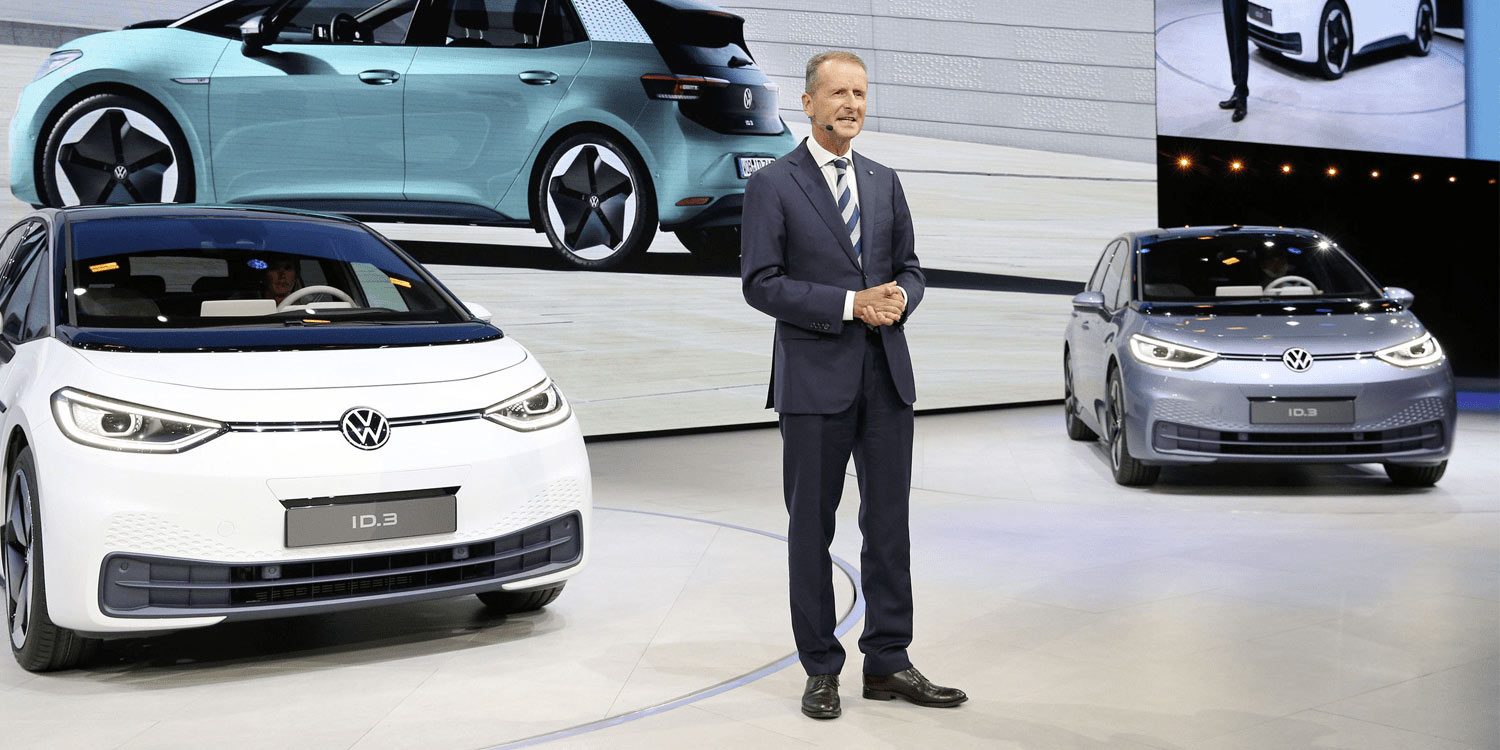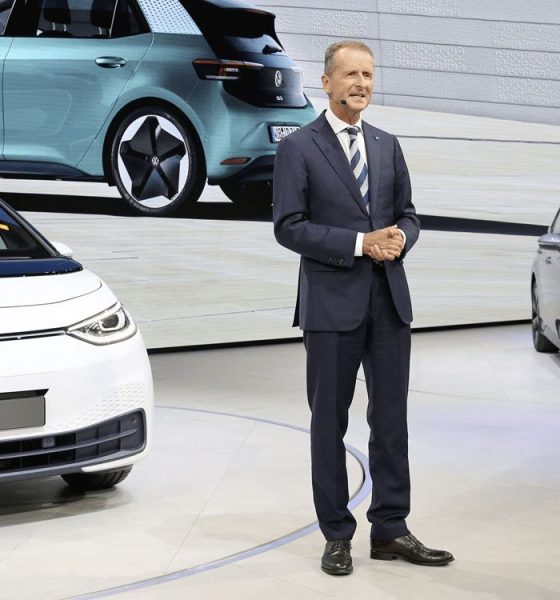

News
As Tesla rises, Volkswagen's largest shareholders back CEO's controversial EV push
As Tesla continues to rise in Europe with the construction of Giga Berlin and the impending local prduction of the Model Y, Volkswagen’s controlling family issued a rare statement of support for CEO Herbert Diess’ aggressive and somewhat controversial electric car push. In a recent statement to local German media, the Porsche-Piech family stated that they are fully backing the CEO in these trying times, as a painful shift to electric cars may be what is required to keep Volkswagen thriving in the coming EV age.
Volkswagen CEO Herbert Diess is a staunch proponent of electric cars, with the company’s first all-electric vehicle, the ID.3, being his personal project. Diess’ dedication for electric cars has earned the respect of Tesla CEO Elon Musk, who has expressed his support for the Volkswagen CEO’s efforts in the past. “Herbert Diess is doing more than any big carmaker to go electric. The good of the world should come first. For what it’s worth, he has my support,” Musk wrote.
Unfortunately for Diess, his aggressive push for electrification has faced sharp criticism. These negative sentiments have only become more prominent as Volkswagen’s ID.3 ramp met roadblocks due to the vehicle’s software. Diess has predicted these challenges, stating that Volkswagen’s shift towards electric mobility is “perhaps the most difficult task VW has ever had to face.” Yet with investors reportedly growing restless, it appeared that the Porsches and Piëchs, Volkswagen’s controlling family, have deemed it pertinent to express their stance.
In a statement to the BILD newspaper on Thursday, Supervisory Board member Hans-Michel Piëch stated that he fully supports Diess’ initiatives. “He has our support. He is faced with an enormous task. For this, he needs strength, but also support from everyone in the Group,” he said. Wolfgang Porsche, Piëch’s cousin, echoed his sentiments. “Even if Mr. Diess is criticized from many sides, he would be taking an insane risk: There is no alternative today to the path that he and the Volkswagen Board of Management have taken,” Porsche said.
Apart from openly supporting Diess’ efforts, the VW majority shareholders explained why the company had gone all-in on electric cars. For example, Diess has taken a strong stance against hydrogen, opting instead to focus solely on electric vehicles. According to Piëch, this is a decision that he and his cousin fully support. “The discussion about a decision for hydrogen or batteries alone is unfortunate. Hydrogen is too expensive for the foreseeable future and simply cannot be produced with sustainable energy,” he said.
Wolfgang Porsche, for his part, has stated that an intense focus on developing next-generation automotive solutions is needed to survive and thrive in the car industry of the future. Seemingly addressing Volkswagen’s current issues with the ID.3’s software, Porsche stated that it is better to tackle the growing pains of electrification now, instead of potentially facing a real risk in the future. “In the future, digitization and software will determine the car. You have to know: If we don’t tackle this transformation now, the company will have a huge problem in the future,” Porsche said.
The coming years will likely be historic for the automotive industry as a whole. Young carmakers such as Tesla have established a hold in the mainstream market, with vehicles such as the Model 3 becoming a viable and even preferable alternative to conventional best-sellers like the BMW M3. With legacy carmakers now realizing the value of electric cars and the importance of battery tech and software, it is in the best interest of Volkswagen to ensure that it invests in the future today. For now, this would likely result in several painful transitions. But if Diess, Piëch, and Porsche’s statements are any indication, it appears that Volkswagen will be willing to take some heavy blows if it means securing a future where the company is still relevant and competitive.
H/T Alex Voigt.

News
Tesla aims to combat common Full Self-Driving problem with new patent
Tesla writes in the patent that its autonomous and semi-autonomous vehicles are heavily reliant on camera systems to navigate and interact with their environment.

Tesla is aiming to combat a common Full Self-Driving problem with a new patent.
One issue with Tesla’s vision-based approach is that sunlight glare can become a troublesome element of everyday travel. Full Self-Driving is certainly an amazing technology, but there are still things Tesla is aiming to figure out with its development.
Unfortunately, it is extremely difficult to get around this issue, and even humans need ways to combat it when they’re driving, as we commonly use sunglasses or sun visors to give us better visibility.
Cameras obviously do not have these ways to fight sunglare, but a new patent Tesla recently had published aims to fight this through a “glare shield.”
Tesla writes in the patent that its autonomous and semi-autonomous vehicles are heavily reliant on camera systems to navigate and interact with their environment.

The ability to see surroundings is crucial for accurate performance, and glare is one element of interference that has yet to be confronted.
Tesla described the patent, which will utilize “a textured surface composed of an array of micro-cones, or cone-shaped formations, which serve to scatter incident light in various directions, thereby reducing glare and improving camera vision.”

The patent was first spotted by Not a Tesla App.
The design of the micro-cones is the first element of the puzzle to fight the excess glare. The patent says they are “optimized in size, angle, and orientation to minimize Total Hemispherical Reflectance (THR) and reflection penalty, enhancing the camera’s ability to accurately interpret visual data.”
Additionally, there is an electromechanical system for dynamic orientation adjustment, which will allow the micro-cones to move based on the angle of external light sources.
This is not the only thing Tesla is mulling to resolve issues with sunlight glare, as it has also worked on two other ways to combat the problem. One thing the company has discussed is a direct photon count.
CEO Elon Musk said during the Q2 Earnings Call:
“We use an approach which is direct photon count. When you see a processed image, so the image that goes from the sort of photon counter — the silicon photon counter — that then goes through a digital signal processor or image signal processor, that’s normally what happens. And then the image that you see looks all washed out, because if you point the camera at the sun, the post-processing of the photon counting washes things out.”
Future Hardware iterations, like Hardware 5 and Hardware 6, could also integrate better solutions for the sunglare issue, such as neutral density filters or heated lenses, aiming to solve glare more effectively.
Elon Musk
Delaware Supreme Court reinstates Elon Musk’s 2018 Tesla CEO pay package
The unanimous decision criticized the prior total rescission as “improper and inequitable,” arguing that it left Musk uncompensated for six years of transformative leadership at Tesla.

The Delaware Supreme Court has overturned a lower court ruling, reinstating Elon Musk’s 2018 compensation package originally valued at $56 billion but now worth approximately $139 billion due to Tesla’s soaring stock price.
The unanimous decision criticized the prior total rescission as “improper and inequitable,” arguing that it left Musk uncompensated for six years of transformative leadership at Tesla. Musk quickly celebrated the outcome on X, stating that he felt “vindicated.” He also shared his gratitude to TSLA shareholders.
Delaware Supreme Court makes a decision
In a 49-page ruling Friday, the Delaware Supreme Court reversed Chancellor Kathaleen McCormick’s 2024 decision that voided the 2018 package over alleged board conflicts and inadequate shareholder disclosures. The high court acknowledged varying views on liability but agreed rescission was excessive, stating it “leaves Musk uncompensated for his time and efforts over a period of six years.”
The 2018 plan granted Musk options on about 304 million shares upon hitting aggressive milestones, all of which were achieved ahead of time. Shareholders overwhelmingly approved it initially in 2018 and ratified it once again in 2024 after the Delaware lower court struck it down. The case against Musk’s 2018 pay package was filed by plaintiff Richard Tornetta, who held just nine shares when the compensation plan was approved.
A hard-fought victory
As noted in a Reuters report, Tesla’s win avoids a potential $26 billion earnings hit from replacing the award at current prices. Tesla, now Texas-incorporated, had hedged with interim plans, including a November 2025 shareholder-approved package potentially worth $878 billion tied to Robotaxi and Optimus goals and other extremely aggressive operational milestones.
The saga surrounding Elon Musk’s 2018 pay package ultimately damaged Delaware’s corporate appeal, prompting a number of high-profile firms, such as Dropbox, Roblox, Trade Desk, and Coinbase, to follow Tesla’s exodus out of the state. What added more fuel to the issue was the fact that Tornetta’s legal team, following the lower court’s 2024 decision, demanded a fee request of more than $5.1 billion worth of TSLA stock, which was equal to an hourly rate of over $200,000.
Delaware Supreme Court Elon Musk 2018 Pay Package by Simon Alvarez
News
Tesla Cybercab tests are going on overdrive with production-ready units
Tesla is ramping its real-world tests of the Cybercab, with multiple sightings of the vehicle being reported across social media this week.

Tesla is ramping its real-world tests of the Cybercab, with multiple sightings of the autonomous two-seater being reported across social media this week. Based on videos of the vehicle that have been shared online, it appears that Cybercab tests are underway across multiple states.
Recent Cybercab sightings
Reports of Cybercab tests have ramped this week, with a vehicle that looked like a production-ready prototype being spotted at Apple’s Visitor Center in California. The vehicle in this sighting was interesting as it was equipped with a steering wheel. The vehicle also featured some changes to the design of its brake lights.
The Cybercab was also filmed testing at the Fremont factory’s test track, which also seemed to involve a vehicle that looked production-ready. This also seemed to be the case for a Cybercab that was spotted in Austin, Texas, which happened to be undergoing real-world tests. Overall, these sightings suggest that Cybercab testing is fully underway, and the vehicle is really moving towards production.
Production design all but finalized?
Recently, a near-production-ready Cybercab was showcased at Tesla’s Santana Row showroom in San Jose. The vehicle was equipped with frameless windows, dual windshield wipers, powered butterfly door struts, an extended front splitter, an updated lightbar, new wheel covers, and a license plate bracket. Interior updates include redesigned dash/door panels, refined seats with center cupholders, updated carpet, and what appeared to be improved legroom.
There seems to be a pretty good chance that the Cybercab’s design has been all but finalized, at least considering Elon Musk’s comments at the 2025 Annual Shareholder Meeting. During the event, Musk confirmed that the vehicle will enter production around April 2026, and its production targets will be quite ambitious.








